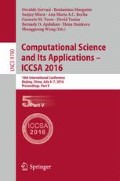Abstract
Remote sensing fire danger prediction model is applied to Northern China. This study was carried out in the Daxing’anling region, which is located in Heilongjiang Province and Inner Mongolia (50.5°–52.25° N, 122°–125.5° E), the northern China. The method integrated by dead fuel moisture content and relative greenness index, which is based on the fire potential index (FPI), was used to predict the fire danger level of the study area. The case that fire happened on the late June 2010 was used to validate the modified method. The results pointed out that the fire affected areas were located in high fire danger level on 26th, 27th, 28th June, 2010 respectively. The ROC analyses of the predicted accuracy on these days were 90.98 %, 73.79 % and 69.07 % respectively. Results from our investigation pointed out the reliability of the adopted method.
Access this chapter
Tax calculation will be finalised at checkout
Purchases are for personal use only
References
Lanorte, A.C., Belviso, R., Lasaponara, F., Cavalcante, F., De Santis: Satellite time series and in situ data analysis for assessing landslide susceptibility after forest fire: preliminary results focusing the case study of Pisticci (Matera, Italy). In: Computational Science and Its Applications–ICCSA 2013, 652anorte A, R Lasaponara 2012 FIRE -SAT un sistema satellitare per il monitoraggio sistematico, dinamico ed integrato degli incendi boschivi: la sperimentazione operativa nella regione Basilicata GEOmedia 16 (2013)
Lasaponara, R.: Geospatial analysis from space: Advanced approaches for data processing, information extraction and interpretation. Int. J. Appl. Earth Obs. Geoinf. 20, 1–3 (2013). Lasaponara, R, Lanorte, A.: Satellite time-series analysis. Int. J. Remote Sens. 33 (15), 4649-4652 (2011)
Lanorte, A., Danese, M., Lasaponara, R., Murgante, B.: Multiscale mapping of burn area and severity using multisensor satellite data and spatial autocorrelation analysis. Int. J. Appl. Earth Obs. Geoinf. 20, 42–51 (2013)
Lanorte, A., Lasaponara, R., Lovallo, M., Telesca, L.: Fisher-shannon information plane analysis of SPOT/VEGETATION Normalized Difference Vegetation Index (NDVI) time series to characterize vegetation recovery after fire disturbance. Int. J. Appl. Earth Obs. Geoinf. 26, 441–446 (2014)
Lasaponara, R.: Inter-comparison of AVHRR-based fire susceptibility indicators for the Mediterranean ecosystems of southern Italy. Int. J. Remote Sens. 26, 853–870 (2005)
Telesca, L., Lasaponara, R.: Pre- and post-fire behavioral trends revealed in satellite NDVI time series. Geophys. Res. Lett. 33(14), 1–4 (2006)
Cuomo, V., Lanfredi, M., Lasaponara, R., Macchiato, M.F., Simoniello, T.: Detection of interannual variation of vegetation in middle and southern Italy during 1985–1999 with 1 km NOAA AVHRR NDVI data. J. Geophys. Res.-Atmos. 106, 17863–17876 (2001)
Tian, X., Shu, L., Wang, M., Zhao, F., Chen, L.: The fire danger and fire regime for the Daxing’anling region for 1987–2010. Procedia Engineering 62, 1023–1031 (2013)
Aguado, I., Chuvieco, E., Boren, R., Nieto, H.: Estimation of dead fuel moisture content from meteorological data in Mediterranean areas. applications in fire danger assessment. Int. J. Wildland Fire 16, 390–397 (2007)
Burgan, R., Klaver, R., Klaver, J.: Fuel models and fire potential from satellite and surface observations. Int. J. Wildland Fire 8, 159–170 (1998)
Burgan R.E., Andrews, P.L., Bradshaw, L.S., Chase, C.H., Hartford, R.A., Latham, D.J.: Current status of the wildland fire assessment system (WFAS). Fire Management Notes, vol. 27, pp. 14–17, (1997). Chuvieco E., Cocero, D., Riano, D., Martin, P., Martinez-Vega, J., de la Riva, J., et al.: Combining NDVI and surface temperature for the estimation of live fuel moisture content in forest fire danger rating. Remote Sensing of Environment, vol. 92, pp. 322–331, August 30 2004
Author information
Authors and Affiliations
Corresponding author
Editor information
Editors and Affiliations
Rights and permissions
Copyright information
© 2016 Springer International Publishing Switzerland
About this paper
Cite this paper
Li, X., Song, W., Lanorte, A., Lasaponara, R. (2016). Remote Sensing Fire Danger Prediction Models Applied to Northern China. In: Gervasi, O., et al. Computational Science and Its Applications – ICCSA 2016. ICCSA 2016. Lecture Notes in Computer Science(), vol 9790. Springer, Cham. https://doi.org/10.1007/978-3-319-42092-9_47
Download citation
DOI: https://doi.org/10.1007/978-3-319-42092-9_47
Published:
Publisher Name: Springer, Cham
Print ISBN: 978-3-319-42091-2
Online ISBN: 978-3-319-42092-9
eBook Packages: Computer ScienceComputer Science (R0)

